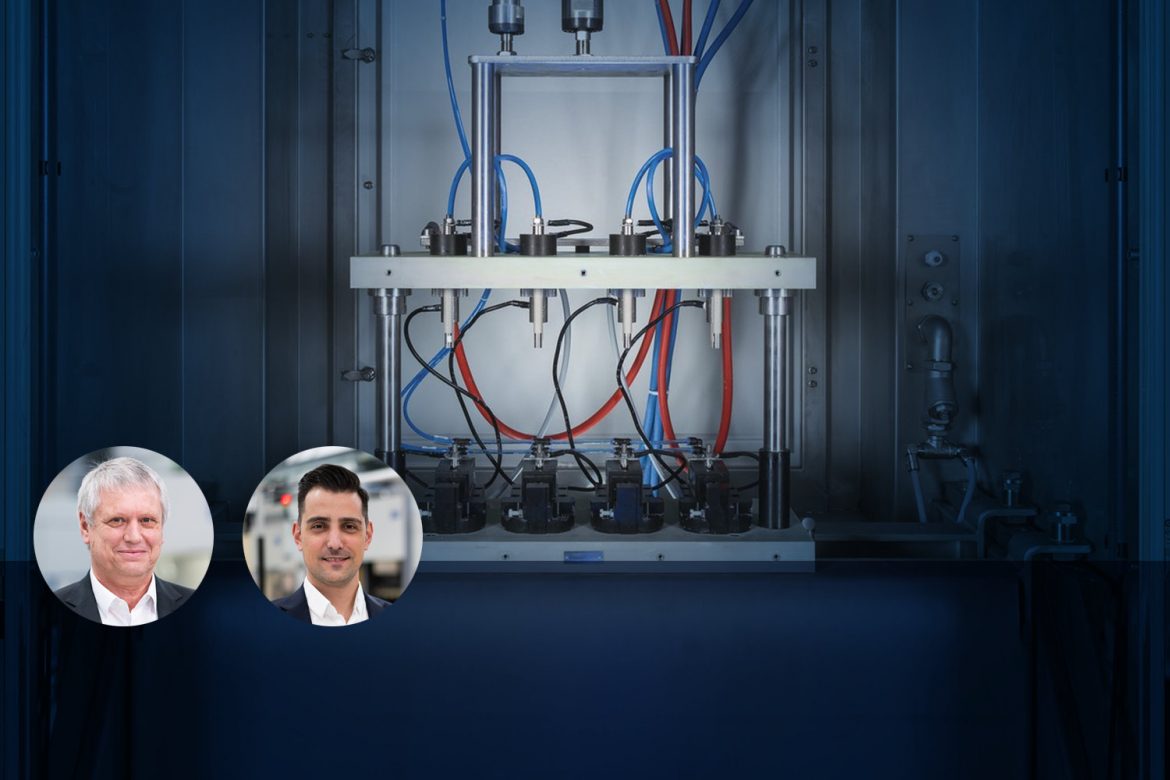ECM (Electrochemical Machining) is being used for a growing range of industrial applications. To date, deburring is customary, but ECM could replace traditional chip-removal manufacturing processes as a better alternative. In the interview, our two ECM experts Fazli Yilmaz and Franz Gross from EMAG ECM explain what ECM is all about.
Mr. Gross, Mr. Yilmaz, many manufacturers still think of ECM as an exotic procedure. How does it work and what advantages does it offer?
Fazli Yilmaz: The procedure makes use of electrolysis. In an electrolyte solution, the tool moves close to a workpiece. A charge passes between the tool (the cathode) and the workpiece (the anode). Material of the workpiece dissolves and is carried away by the electrolyte. Clean electrolyte flows in each time before the tool advances. A key advantage of the procedure is the fact that the tool and workpiece do not come in contact with each other. We achieve feed rates of between 0.2 mm for machining detailed parts and 4 mm for broaching.
Franz Gross: ECM has lower tool wear than chipping processes. The workpiece is also treated more gently, as it is not subjected to any mechanical or thermal stress. This prevents changes to the mechanical material properties and guarantees a high reproducibility. Depending on the material, we achieve a surface quality of Ra 0.05 µm and higher. With a clever tool design, areas that are difficult to access can still be machined very well, and complicated shapes are possible even inside components. ECM is particularly suitable for components used in motor and transmission engineering, or in fluidics, but also for medical technology and aerospace applications.
What materials cannot be machined with the ECM procedure?
Fazli Yilmaz: Fundamentally, all electrically conductive metals are suitable, from normal and high-alloyed steel to aluminum. It does not matter whether it is soft aluminum or hardened steel, the process stays the same and the processing times change only very slightly, even when machining particularly hard nickel-base alloys.
What are the cathodes made of and who makes them?
Fazli Yilmaz: We usually use customary austenitic stainless steels, 1.4301 (X5CrNi18-10) or 1.4303 (X5CrNi18-10), which are very corrosion-resistant and can be easily machined with traditional methods. They do not have to be hardened. Any customer that has the corresponding machines at their disposal can make the cathodes themselves.
Franz Gross: We also offer it as a service. In the beginning, it is recommended to gain expertise with our help, in the framework of a turnkey project. If desired, the customer can get everything from us as a one-stop provider: the entire process with machine, tools, equipment, automation, etc.
Which controls do you use and how can the process be automated?
Franz Gross: We use Siemens controls exclusively. For the C-machines, we will use the Simatik S7-1500 in the future. For the larger P-machines, we use the Sinumerik 840D sl. The programming of both controls is identical. For a new workpiece, all you have to do is call up the corresponding stored type program and enter the appropriate parameters. It is very easy to create and run in a type.
Fazli Yilmaz: All machines can be loaded manually or automatically, with a gantry system or by a robot. An interesting option is the possibility of starting manually and then automating as the quantities increase. Additionally, multiple machining is possible.
What does the electrolyte management look like?
Franz Gross: It is a closed process. All the material that is removed goes into the electrolyte management system with filtration. This can be an integral component of the standalone machines, or a separate electrolyte management system that is connected to several ECM modules.
Fazli Yilmaz: In the management system, the dirty electrolyte is filtered several times. Different filtration options are available, from easily replaceable cartridges and chamber filter presses to microfiltration with backflushing. The latter filters a particle size of 0.5 µm; in other words, we effectively always have pure electrolyte in the process. On average, the electrolyte should be replaced once a year, but it depends on each individual case. The electrolyte is conditioned automatically and the pH value is kept neutral.
What does it all cost?
Franz Gross: An integrated standalone machine for deburring or drilling costs around 180,000 to 220,000 euros, depending on the tools and the complexity. For a modular machine with external electrolyte management, the initial investment will be somewhat more, but that equals out later because additional CS modules cost less. It is difficult to put a general price on the PECM standalone and modular machines for broaching and machining, as the cost is heavily dependent on the application and the technical concept.
About EMAG ECM
EMAG ECM GmbH in Heubach, Germany, specializes in electrochemical machining. The deburring step of the
machining process frequently affects the profitability of the entire system, as it is frequently overlooked during the planning stage. With EMAG ECM, the EMAG Group closes this gap and is the first company to offer the entire machining process, including deburring, from a single source. Additionally, the procedure has become so advanced that it now frequently is a better alternative than chipping for many drilling, broaching, and machining cases.
